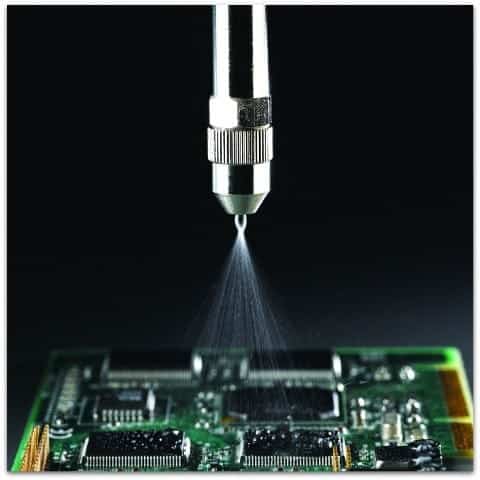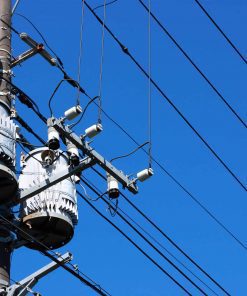Miller-Stephenson Articles
Choosing the Right Conformal Coatings
How Miller-Stephenson can help you choose the right Conformal Coating
Miller-Stephenson offers a complete series of electronic conformal coatings to meet any applicators protection requirements. Urethane, Acrylic, Silicone, and Varnish coatings are available, each exhibiting specific chemical, mechanical and moisture resistance. Formulated with high performance base resins, Miller-Stephenson’s conformal coatings promote extended service life and enhanced reliability for your PCB components and assemblies. Conformal coatings are particularly useful for protecting circuitry in severe service environments, while maintaining a low stress environment for components and connections. These severe conditions range from every day temperature and humidity extremes seen in consumer electronics, to the more harsh automotive underhood applications, up to the extremes demanded in military or industrial applications. All of our formulations are 100% nonflammable and available in both an aerosol and bulk packaging.
What are Conformal Coatings?
Conformal coatings are specialized film forming polymers that protect circuit boards and other electronic components from adverse environmental conditions and mechanical abrasion. These coatings ‘conform’ to the irregular topography of a electronic circuit board, providing increased dielectric resistance, operational and structural integrity, and protection from corrosive elements, moisture, heat, fungus, and airborne contaminants such as dirt and dust. With continued miniaturization of electronics, the necessity of conformal coating has increased because necessity for an additional insulative coating layer between circuits to prevent arcing or current bleed.
Conformal coatings are also “breathable”, allowing trapped moisture in electronic boards to escape while maintaining protection from environmental contaminates. However these coatings are not sealants, and prolonged exposure to vapors will cause transmission and degradation to occur. There are typically four classes of conformal coatings : Acrylic, Urethane, Silicone, and Varnish. While each has its own specific physical and chemical properties each are able to perform the following functions:
- Insulation: Allowing reduction in conductor spacing
- Eliminate the need for complex, sophisticated enclosures
- Minimal effect on component weight
- Completely protect the assembly against chemical and corrosive attack
- Eliminate potential performance degradation due to environmental hazards
- Minimize environmental stress on a PCB assembly
Types of Conformal Coating:
- ACRYLIC: Acrylic coatings provide fair elasticity and general protection. As one‐part systems, they are easy to apply, remove, and re-work. Acrylic conformal coatings are recognized for their high dielectric strength, abrasion resistance and ease of removal.
- SILICONE: Silicone coatings provide excellent protection in a very wide temperature range, have high dielectric strength, and low excellent self-leveling properties. They provide good chemical resistance, UV resistance, salt spray resistance and are very flexible. This is the coating least compatible with all of the other coating types. Our highest performing silicone conformal coating is our ShieldSys™ 462S
- URETHANE: Polyurethane coatings are known for their excellent moisture and chemical resistance and good dielectric properties. They are also very abrasion resistant. Urethanes typically require specialized stripping solvents like MS-114 Conformal Coating Stripper. Miller-Stephenson next-generation urethane conformal coating is the ShieldSys™ 470
- VARNISH: Varnish coatings are natural‐based resins that form tough coatings which are moisture resistant materials that lack the flexibility of the above materials, and also have greater variations in insulative properties and stability.
Equally as important as choosing the correct resin is proper application and cure of the coating. To be effective, a coating should completely cover the assembly and provide good coverage of sharp edges (components and component leads) and other contours (solder joints, etc). It may even be essential to coat the edge to generate a ubiquitous layer throughout the entire board or device
 Applying Protective Coatings:
Applying Protective Coatings:
The effectiveness of the coating is influenced by the efficiency of the application method, which also governs the type of coating used. Typically coating thickness of 1-2 mil is recommended to ensure coating robustness, uniform coverage, and long-term stability. Thicker coatings can be applied however dielectric properties of the coating may be effected. There are the three main ways of applying a conformal coating:
- Dipping – limited to materials that do not cure quickly by moisture, oxidation or light
- Selective robotic coating – such as Asymtek. All coating types can be used if the correct dispense head is selected
- Spraying – hand spray using a spray booth or aerosol can. All coatings can be applied in this way
The liquid coating application should thoroughly wet all surfaces and cure without leaving surface defects. Defects typically observed are hazy or cloudiness, air bubbles, irregular leveling (known as orange peel), or voids. These defects can have substantial effects on the final performance of the coating and one should consider re-working the PCB. Cleanliness of the substrate is of extreme importance for the successful application of a coating. Surfaces must be free of moisture, dirt, wax, grease, flux residues and all other contaminants. Contamination under the coating could cause problems that may lead to assembly failures.
Miller-Stephenson has been manufacturing and formulating conformal coatings for over 50 years, we have the technical and application expertise to help your team choose, apply, and re-work any conformal coating within our portfolio. We offer both commercial and MIL-spec coatings, and all of our coatings are held to highest performance standards. When choosing any of our conformal coating you can expect the following benefits:
- Simple application- Convenient aerosol or bulk
- Specialized formulas to provide uniform, thin films
- Easy removal, repair and replacement
- 100% non-flammable; low odor formulations
- Superior Protection against thermal and mechanical shock
- MIL-Spec and Commercial-Spec polymer coatings
These products can also be found on Ellsworth here.
The recommendation made here with and the information set forth with respect to the performance or use of our products are believed, but not warranted to be accurate. The products discussed are sold without warranty, as to fitness or performance, express or implied and upon condition that purchasers shall make their own test to determine suitability of such products for their particular purposes. Likewise, statements concerning the possible uses of our products are not intended as recommendations to use our products in the infringement of any patent.


 Applying Protective Coatings:
Applying Protective Coatings:

